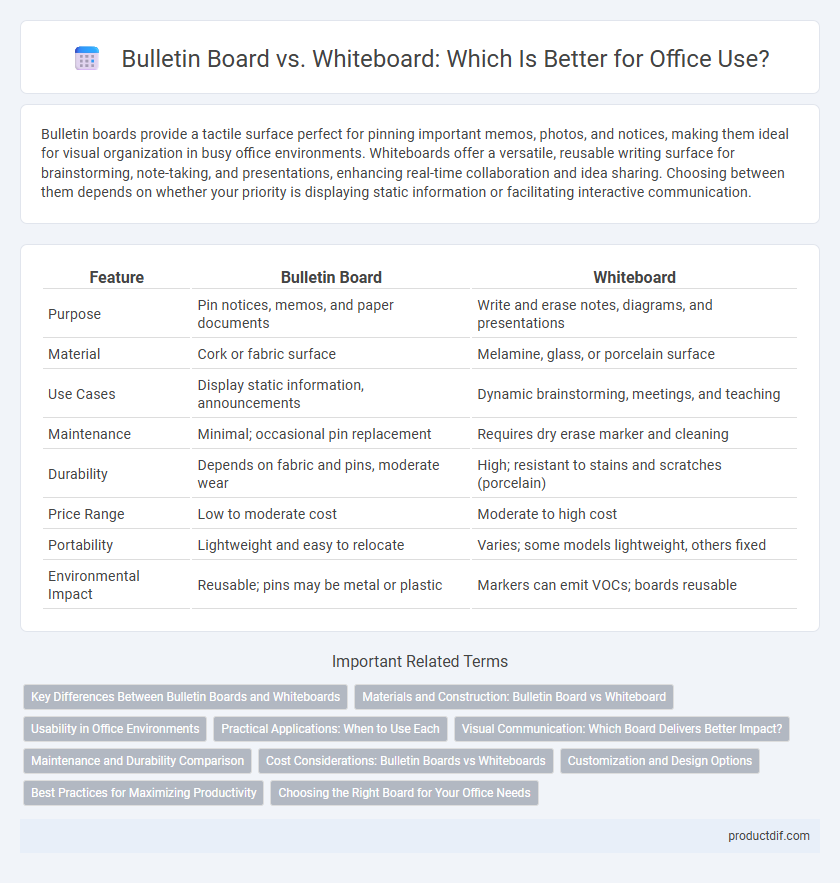Bulletin boards provide a tactile surface perfect for pinning important memos, photos, and notices, making them ideal for visual organization in busy office environments. Whiteboards offer a versatile, reusable writing surface for brainstorming, note-taking, and presentations, enhancing real-time collaboration and idea sharing. Choosing between them depends on whether your priority is displaying static information or facilitating interactive communication.
Table of Comparison
| Feature | Bulletin Board | Whiteboard |
|---|---|---|
| Purpose | Pin notices, memos, and paper documents | Write and erase notes, diagrams, and presentations |
| Material | Cork or fabric surface | Melamine, glass, or porcelain surface |
| Use Cases | Display static information, announcements | Dynamic brainstorming, meetings, and teaching |
| Maintenance | Minimal; occasional pin replacement | Requires dry erase marker and cleaning |
| Durability | Depends on fabric and pins, moderate wear | High; resistant to stains and scratches (porcelain) |
| Price Range | Low to moderate cost | Moderate to high cost |
| Portability | Lightweight and easy to relocate | Varies; some models lightweight, others fixed |
| Environmental Impact | Reusable; pins may be metal or plastic | Markers can emit VOCs; boards reusable |
Key Differences Between Bulletin Boards and Whiteboards
Bulletin boards provide a tactile display surface for pinning paper-based notices, photos, and memos, making them ideal for long-term, static information sharing in office environments. Whiteboards offer a smooth, erasable surface for dynamic writing, brainstorming, and collaborative discussions, supporting frequent updates and interactive meetings. The key difference lies in the medium of information presentation--bulletin boards excel in showcasing fixed content, while whiteboards facilitate real-time communication and idea exchange.
Materials and Construction: Bulletin Board vs Whiteboard
Bulletin boards are typically constructed with cork or fabric surfaces mounted on a wooden or metal frame, allowing easy pinning of papers and notices. Whiteboards feature a smooth, non-porous surface made of materials like melamine, porcelain, or glass, designed for dry-erase markers and easy cleaning. The durability of porcelain whiteboards exceeds cork bulletin boards, making them suitable for frequent use and long-term writing.
Usability in Office Environments
Bulletin boards offer a tactile, pin-based solution ideal for displaying physical documents, reminders, and notices that require frequent updates or collaborative input in office environments. Whiteboards provide versatile, reusable surfaces for real-time brainstorming, presentations, and interactive meetings, enhancing communication efficiency and team engagement. Choice depends on whether the need leans toward static information sharing or dynamic visual collaboration in office workflows.
Practical Applications: When to Use Each
Bulletin boards excel in displaying important notices, reminders, and static documents, making them ideal for office environments requiring constant visual communication and organization. Whiteboards offer dynamic interaction, perfect for brainstorming sessions, collaborative meetings, and real-time note-taking where flexibility and quick updates are necessary. Choosing between these tools depends on the need for either fixed information display or interactive planning and idea sharing.
Visual Communication: Which Board Delivers Better Impact?
Bulletin boards excel in tactile and static visual communication, allowing for pinned notes, documents, and diverse materials that create a layered, tangible impact. Whiteboards excel in dynamic, real-time interaction, offering smooth erasability for spontaneous ideas, sketches, and collaborative brainstorming sessions. Choosing between the two depends on whether long-term display or interactive, evolving content better suits the office's communication needs.
Maintenance and Durability Comparison
Bulletin boards require minimal maintenance, typically involving occasional dusting and pin replacement, while whiteboards need regular cleaning with appropriate markers and solutions to prevent ghosting and stains. In terms of durability, bulletin boards are generally more resistant to wear and tear due to their fabric or cork surfaces, whereas whiteboards can suffer from surface scratches and marker residue over time. Choosing between the two depends on the frequency of use and maintenance willingness; bulletin boards offer longevity with low upkeep, while whiteboards demand consistent care for sustained clarity.
Cost Considerations: Bulletin Boards vs Whiteboards
Bulletin boards typically have a lower upfront cost than whiteboards, making them a budget-friendly option for offices needing a simple display surface. Whiteboards often require additional investments in markers, erasers, and cleaning supplies, which can increase their overall expense over time. Considering durability and maintenance, bulletin boards may offer better long-term value for cost-conscious businesses prioritizing minimal upkeep.
Customization and Design Options
Bulletin boards offer extensive customization through various fabric colors, pin styles, and frame materials, catering to diverse interior designs and branding needs. Whiteboards provide design flexibility with magnetic surfaces, writable films, and customizable sizes, enhancing functionality and visual appeal in professional settings. Both options can be tailored to specific office aesthetics, promoting organized communication and collaborative work environments.
Best Practices for Maximizing Productivity
Bulletin boards offer a tactile, visual way to organize important documents, leveraging color-coded pins and categories to prioritize tasks effectively. Whiteboards enable dynamic brainstorming and real-time updates, making them ideal for agile workflows and collaborative meetings. Combining both tools strategically enhances productivity by accommodating varied information types and interaction styles in office environments.
Choosing the Right Board for Your Office Needs
Bulletin boards offer a tactile way to display important notices, memos, and paper-based communications ideal for collaborative office environments, while whiteboards provide versatile, reusable surfaces perfect for brainstorming sessions, quick note-taking, and visual presentations. Selecting the right board depends on your office workflow: bulletin boards excel in static information sharing, whereas whiteboards support dynamic and interactive discussions. Prioritize factors such as space availability, frequency of updates, and the team's communication style to optimize productivity with the appropriate board type.
Bulletin Board vs Whiteboard Infographic

 productdif.com
productdif.com